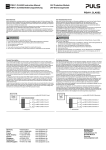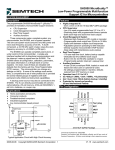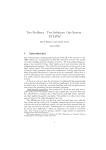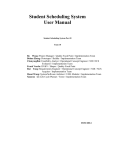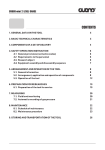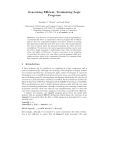Download ECRC-95-17
Transcript
A Tutorial on Parallelism and Constraints in ECLiPSe Steven Prestwich ECRC-95-17 technical report ECRC-95-17 A Tutorial on Parallelism and Constraints in ECLiPSe Steven Prestwich European Computer-Industry Research Centre GmbH (Forschungszentrum) Arabellastrasse 17 D-81925 Munich Germany Tel. +49 89 9 26 99-0 Fax. +49 89 9 26 99-170 Tlx. 52 69 10 I c European Computer-Industry Research Centre, 1995 Although every effort has been taken to ensure the accuracy of this report, neither the authors nor the European Computer-Industry Research Centre GmbH make any warranty, express or implied, or assume any legal liability for either the contents or use to which the contents may be put, including any derived works. Permission to copy this report in whole or in part is freely given for non-profit educational and research purposes on condition that such copies include the following: 1. a statement that the contents are the intellectual property of the European Computer-Industry Research Centre GmbH 2. this notice 3. an acknowledgement of the authors and individual contributors to this work Copying, reproducing or republishing this report by any means, whether electronic or mechanical, for any other purposes requires the express written permission of the European Computer-Industry Research Centre GmbH. Any registered trademarks used in this work are the property of their respective owners. For more information please contact : [email protected] II Abstract This is a tutorial for the working programmer on the ECLi PSe parallel constraint logic programming language. It assumes previous experience of ECLiPSe , or at least some version of Prolog, and introduces the parallelism and constraints features. For further details on these and other features see the User Manual and Extensions User Manual. III Contents 1 Introduction 1.1 How to read this tutorial 3 : : : : : : : : : : : : : : : : : : : : : : : 2 OR-Parallelism 2.1 2.2 2.3 2.4 How to use it : : : : : : : : : : : : : : : How it works : : : : : : : : : : : : : : : 2.2.1 Continuations : : : : : : : : : : : When to use it : : : : : : : : : : : : : : 2.3.1 Non-deterministic calls : : : : : : 2.3.2 Side effects : : : : : : : : : : : : 2.3.3 The commit operator : : : : : : : 2.3.4 Parallelisation overhead : : : : : 2.3.5 Grain size for all solutions : : : : 2.3.6 Grain size for one solution : : : 2.3.7 Grain size and pruning operators 2.3.8 Grain size and coroutining : : : : 2.3.9 Parallelisation of predicates : : : 2.3.10 Parallelisation of calls : : : : : : 2.3.11 Partial parallelisation : : : : : : : 2.3.12 Parallelisation of disjunctions : : 2.3.13 Speedup : : : : : : : : : : : : : : Summary : : : : : : : : : : : : : : : : : 4 : : : : : : : : : : : : : : : : : : : : : : : : : : : : : : : : : : : : : : : : : : : : : : : : : : : : : : : : : : : : : : : : : : : : : : : : : : : : : : : : : : : : : : : : : : : : : : : : : : : : : : : : : : : : : : : : : : : : : : : : : : : : : : : : : : : : : : : : : : : : : : : : : : : : : : : : : : : : : : : : : : : : : : : : : : : : : : : : : : : : : : : : : : : : : : : : : : : : : : : : : : : : : : : : : : : : : : : : : : : : : : : : : : : : : : : : : : : : : : : : : : : : : : : : : : : : 3 Independent AND-parallelism 3.1 3.2 3.3 3.4 How to use it : : : : : : : : : : : How it works : : : : : : : : : : : When to use it : : : : : : : : : : 3.3.1 Non-logical calls : : : : : 3.3.2 Non-terminating calls : : : 3.3.3 Shared variables : : : : : 3.3.4 Parallelisation overhead : 3.3.5 Conditional parallelisation 3.3.6 Speedup : : : : : : : : : : Summary : : : : : : : : : : : : : 4 5 5 6 6 6 7 9 10 11 11 12 13 15 16 17 17 18 20 : : : : : : : : : : : : : : : : : : : : : : : : : : : : : : : : : : : : : : : : : : : : : : : : : : : : : : : : : : : : : : : : : : : : : : : : : : : : : : : : : : : : : : : : : : : : : : : : : : : : : : : : : : : : : : : : : : : : : : : : : : : : : : : : : : : : : : : : : : : : : : : : : : : : : : : : : : : : : : : : : : : : : : : : : : : : : : : : : : : : 4 Finite Domain constraint handling 4.1 4.2 3 Description of the 8-queens problem Logic programming methods : : : : : 4.2.1 Generate-and-test : : : : : : : 4.2.2 Test-and-generate : : : : : : : 4.2.3 Standard backtracking : : : : 20 20 21 21 22 23 24 25 25 26 27 : : : : : : : : : : : : : : : : : : : : : : : : : : : : : : : : : : : : : : : : : : : : : : : : : : : : : : : : : : : : : : : : : : : : : : : : : : : : : : : : 27 27 28 28 29 1 4.3 4.4 4.5 4.6 4.2.4 Forward checking : : : : : : : Constraint logic programming methods 4.3.1 Forward checking : : : : : : : 4.3.2 Generalised forward checking : 4.3.3 The first-fail principle : : : : : 4.3.4 Maximising propagation : : : : Non-logical calls : : : : : : : : : : : : Parallelism : : : : : : : : : : : : : : : : Summary : : : : : : : : : : : : : : : : : : : : : : : : : : : : : : : : : : : : : : : : : : : : : : : : : : : : : : : : : : : : : : : : : : : : : : : : : : : : : : : : : : : : : : : : : : : : : : : : : : : : : : : : : : : : : : : : : : : : : : : : : : : : : : : : : : : : : : : : : : : : : : : : : : : : : : : A Calculating parallel speedup A.1 The obvious definition : : : : : : A.2 A better definition : : : : : : : : A.2.1 A note on calculation : : A.2.2 Other applications : : : : A.2.3 Quasi standard deviation : A.3 Speedup curves : : : : : : : : : : 30 30 30 30 31 32 33 33 34 35 : : : : : : : : : : : : : : : : : : : : : : : : : : : : : : : : : : : : : : : : : : : : : : : : : : : : : : : : : : : : : : : : : : : : : : : : : : : : : : : : : : : : : : : : : : : : : : : : : : : : : : : : : : : : 35 36 36 36 37 37 2 1 Introduction Logic programming has the well-known advantages of ease of programming (because of its high level of abstraction) and clarity (because of its logical semantics). The main drawback is its slow execution times compared to those of conventional, imperative languages. In recent years, research has produced various extensions which make such systems competitive. ECLi PSe , the ECRC Prolog platform, is a logic programming system with several extensions. Two of these extensions are targeted at problems with large search spaces; these are constraint handling and parallelism . Constraints are used to prune search spaces, whereas parallelism exploits parallel or distributed machines to search large spaces more quickly. These complementary techniques can be used separately or combined to obtain clear, concise and efficient programs. These extensions originated in other ECRC systems: constraint handling came from CHIP and the parallelism from ElipSys, both with some changes. This tutorial is adapted and extended from a similar tutorial for ElipSys [5]. It provides some general principles on how to make the best use of parallelism and constraints. It is intended as an introduction for the working programmer, and does not contain details of all the built-in predicates available. These details can be found in the Manuals. 1.1 How to read this tutorial If you are just interested in OR-parallelism then go directly to Chapter 2, which is self-contained. This is the most important form of parallelism in ECLi PSe . If you are just interested in AND-parallelism then read Chapter 2 followed by Chapter 3, because 2 contains information necessary to understand 3. When you are ready to test OR- or AND- parallel programs for performance, Appendix A describes how to handle timing variations when calculating parallel speedups, and includes a note on speedup curves. If you are just interested in constraints then jump to Chapter 4 which is self contained, except for Section 4.5 which links the ideas of constraints and parallelism. If you are interested in all aspects of parallelism and constraints, then just read the chapters in order. 3 2 OR-Parallelism Many programming tasks can be naturally split into two or more independent subtasks. If these subtasks can be executed in parallel on different processors, much greater speeds can be achieved. Parallel hardware is becoming cheaper and more widely available, but programming these machines can be much more difficult than programming sequential machines. Using conventional, imperative languages may involve the programmer in a great deal of low-level detail such as communication, load balancing etc. This difficulty in exploiting the hardware is sometimes called the programming bottleneck . ECLi PSe avoids this bottleneck. It exploits parallel hardware in an almost transparent way, with the system taking most of the low-level decisions. However, there are still certain programming decisions to be made regarding parallelism, and this tutorial gives some practical hints on how to make these decisions. In the future even greater transparency will be achieved as analysis and transformation tools are developed. 2.1 How to use it First, we must tell ECLiPSe how many processors to allocate for the program. One way to do this is to specify the number of workers when parallel ECLi PSe is called. For example peclipse -w 3 calls parallel ECLi PSe with 3 workers. If no number of workers is specified, ECLi PSe will simply run sequentially with the default of 1 worker. Other ways of changing the number of workers are described in [1, 2]. For the purpose of this tutorial we shall assume that a worker and a processor are the same thing, though there is a subtle difference: it is possible to specify a greater number of workers than there are processors, in which case ECLi PSe will simulate extra processors. Simulated parallelism is useful for some search algorithms, as it causes the program to search in a more “breadth-first” way. However, it does add an overhead and uses more memory, so it should only be used when necessary. Note: As a simple example, here is part of a program: p(X) :- p1(X). p(X) :- p2(X). 4 In a standard Prolog execution, a call to p will first enumerate the answers to p1, then on backtracking those of p2. We can tell ECLi PSe to try p1 and p2 in parallel instead of by backtracking simply by inserting a declaration :- parallel p/1. p(X) :- p1(X). p(X) :- p2(X). The set of answers for p will still be the same in parallel as in the backtracking computation, though possibly in a different order. For convenience, some built-in predicates have been pre-defined as OR-parallel in the library par_util. For example par_member/2 is an OR-parallel version of the list membership predicate member/2. Before defining new parallel predicates it is worth checking whether they already exist in the library. 2.2 How it works The computation of p splits into two (or more if there are more p clauses) parallel computations which may be executed on separate workers if any are available, and if ECLi PSe decides to do so — these decisions are made automatically by the ECLi PSe task scheduler, and need not concern the programmer. 2.2.1 Continuations Not only will p1 and p2 be computed in parallel, but also any calls occurring after p in the computation. This part of the computation is called the continuation of the p call. For example, if p is called from another predicate: q(X,Y) :- r(X), s(X), t(Y). s(X) :- u(X), p(X), v(X). :- parallel p/1. p(X) :- p1(X). p(X) :- p2(X). 5 then p(X) has two alternative continuations in a computation of :- q(f(A),Y): p1(f(A)), v(f(A)), t(Y) p2(f(A)), v(f(A)), t(Y) and it is these processes which will be assigned to separate workers. The idea of a continuation plays a large part in deciding where to use OR-parallelism. 2.3 When to use it When should we declare predicates as OR-parallel? It may appear that all predicates with more than one clause should be parallel, but this is wrong. In this section we discuss why it is wrong, indicate possible pitfalls, and consider the effects of OR-parallelism on execution times. 2.3.1 Non-deterministic calls Since a parallel declaration tells the system that the clauses of the predicate should be tried in parallel, clearly only predicates with more than one clause are candidates. Furthermore, deterministic predicates should not be parallel, that is those whose calls only ever match one clause at runtime. For example, the standard list append predicate: append([],A,A). append([A|B],C,[A|D]) :- append(B,C,D). is commonly called with its first argument bound to concatenate two lists. Only one clause will match any such call, and there is no point in making append parallel. If append is called in other modes, for example with only its third argument bound, then it is nondeterministic and may be worth parallelising. 2.3.2 Side effects Only predicates whose solution order is unimportant should be parallel. An example of a predicate whose solution order may be important is p :- generate1(X), write(X). p :- generate2(X), write(X). p :- generate3(X), write(X). 6 q :- ... p(X) ... :- parallel p/1. p(X) :- guard1(X), !. p(X) :- guard2(X), !. p(X) :- guard3(X), !. Figure 2.3.1: A simple predicate with commit where generate{1,2,3} generate values for X non-deterministically. If p is parallelised then the order of write’s may change. In fact any side effects in the continuation of a parallel call may occur in a different order. This may or may not be important, only the programmer can decide. Even if solution order is unimportant, it is recommended that any predicates with side effects such as read, write or setval are only used in sequential parts of the program, otherwise the performance of the system may be degraded. The OR-parallelism of ECLi PSe is really designed to be used for pure search. If parallel solutions are to be collected then there are built-in predicates like findall which should be used. 2.3.3 The commit operator When the cut ! is used in parallel predicates, it has a slightly different meaning than in normal (sequential) predicates. When used in parallel in ECLi PSe it is called the commit operator. Its meaning can be explained using examples. First consider Figure 2.3.1. The “guards” execute in parallel, and as soon as one finds a solution the commit operator aborts the other two guards. Only the continuation of the successful guard survives. This simple example can be written in another way using the once meta-predicate, as in Figure 2.3.2. This is a matter of preferred style. In the more general case there may be calls after the commits, as in Figure 2.3.3. The commit has exactly the same effect as before, with the body calls at the start of the parallel continuations. By the way, this example cannot be rewritten using once without a little program restructuring, because of the body calls. Some predicates may have an empty guard, corresponding to (for example) the “else” in Pascal. An example is shown in Figure 2.3.4 The meaning of this predicate is “if guard1 then body1, else if guard2 then body2, else body3”. This must not be parallelised simply by adding a declaration, because the empty 7 q :- ... once(p(X)) ... :- parallel p/1. p(X) :- guard1(X). p(X) :- guard2(X). p(X) :- guard3(X). Figure 2.3.2: Replacing commits by \once" in a simple parallel predicate q :- ... p(X) ... :- parallel p/1. p(X) :- guard1(X), !, body1(X). p(X) :- guard2(X), !, body2(X). p(X) :- guard3(X), !, body3(X). Figure 2.3.3: A less simple predicate with commit p(X) :- guard1(X), !, body1(X). p(X) :- guard2(X), !, body2(X). p(X) :body3(X). Figure 2.3.4: A typical sequential predicate with empty guard 8 p(X) :guard1(X), !, body1(X). p(X) :guard2(X), !, body2(X). p(X) :- not guard1(X), not guard2(X), !, body3(X). Figure 2.3.5: Handling empty guards when parallelising p(X) :- guards(X,N), !, bodies1_and_2(N,X). p(X) :- body3(X). :- parallel guards/2. guards(X,1) :- guard1(X). guards(X,2) :- guard2(X). bodies_1_and_2(1,X) :- body1(X). bodies_1_and_2(2,X) :- body2(X). Figure 2.3.6: Another way of handling empty guards when parallelising guard may change the meaning of the program when executed in parallel. The reason is that if we make p parallel then we may get body3 succeeding followed by (guard1, !, body1) or (guard2, !, body2) giving more solutions for p than in backtracking mode. It is safer to use commits in each of the p clauses and to introduce a new guard, as in Figure 2.3.5. This is now safe, but at the expense of introducing extra work (the negated guards in the third clause). A safe and efficient method, though slightly more complicated, is shown in Figure 2.3.6 where we split the definition of p into parallel and sequential parts. 2.3.4 Parallelisation overhead Even if a program is safely parallelised it may not be worthwhile making a predicate parallel. For example, in a Quick Sort program there is typically a partition predicate as shown in Figure 2.3.7. Although for most calls to partition both clauses 2 and 3 will match, one of them will fail almost partition([],_,[],[]). partition([H|T],D,[H|S],B) :- H<D, partition(T,D,S,B). partition([H|T],D,S,[H|B]) :- H>=D, partition(T,D,S,B). Figure 2.3.7: Quick Sort partitioning predicate 9 process_value :value(X), process(X). value(1). value(2). : value(n). Figure 2.3.8: Grain size estimation immediately because of the comparison H<D or H>=D. There is no point in making partition parallel because the overhead of starting a parallel process will greatly outweigh the small advantage of making the comparisons in parallel. To express the fact that the overhead of spawning parallel processes is equivalent to a significant computation (depending upon the hardware, perhaps as much as several hundred resolution steps) we say that . The of a parallel ECLi PSe supports task refers to the cost of its computation, roughly equivalent to its cpu time. Only computations with grain size at least as large as this overhead are worth executing in parallel, in fact the grain size should be much larger than the . overhead. Computations which are not coarse-grained are called coarse-grained parallelism grain size ne-grained Estimating grain sizes is usually not as obvious as in the Quick Sort example. In fact it is the most difficult aspect of using OR-parallelism, and we therefore spend some time discussing it. In the context of OR-parallelism, a parallel task is a continuation, and so when we refer to the grain size of a parallel predicate call we mean the time taken to execute that call plus its continuation. To illustrate this, consider the program in Figure 2.3.8, where process(X) performs some computation using the value of X. Now the question is, should value be parallel? The answer depends upon the computations of the various process calls since the value calls are fine-grained. We now discuss this question in some detail. 2.3.5 Grain size for all solutions Say that we require all solutions of process_value. In a backtracking computation the total time to execute process_value is approximately t1 + : : : + tn where ti = time(process(i)). In an OR-parallel computation (assuming sufficient workers are available) the total computation time is approximately k + maximum(t1 : : : tn) 10 where k is the overhead of starting a parallel process, which is machine and implementation dependent. As can be seen from the formulae, if process has no expensive calls then k becomes significant, and the backtracking computation is faster; one expensive call then the sequential and parallel cases will take about the same time; two or more expensive calls then k is insignificant and the parallel computation is faster. The programmer must try to ensure that at least two continuations have significant cost. 2.3.6 Grain size for one solution Say that we only require process_value to succeed once. In a backtracking computation the time will be t1 + : : : + ts where s is the number of the first succeeding process(s). In a parallel computation the time will be k + minimum(t1 : : :tn) Now the parallel computation is only cheaper if there are of i s for which process(i) is expensive. 2.3.7 one or more values Grain size and pruning operators Pruning operators such as the commit may affect estimates of the grain size of a continuation. Consider the program in Figure 2.3.9. Here n processes will be spawned with continuations process1(1), !, process2(1). : process1(n), !, process2(n). As soon as process1 on one worker succeeds, all the other workers will abandon their computations. Hence the actual grain size of any continuation of an OR-parallel call is no greater than that of the cheapest process before pruning occurs. Of course, it may be smaller than this if failure occurs before the pruning operator is reached. 11 one_process_value :value(X), process1(X), !, process2(X). :- parallel value/1. value(1). value(2). : value(n). Figure 2.3.9: Grain size estimation and an obvious commit p1 :- p2, !. p2 :- process_value, p3. process_value :value(X), process(X), Figure 2.3.10: Grain size estimation and a less obvious commit In fact, we must consider the effects of commits in any predicate which calls a parallel predicate, even indirectly. For example, see the program in Figure 2.3.10. Since p1 contains a commit which prunes p2, and p2 calls value (indirectly), we only need to estimate the grain size of the continuation up to the commit, that is the grain size of process(X), p3 The same holds for any pruning operator, including once/1, not/1 and -> (if-then-else) because these contain implicit commits. When we talk about a continuation for an OR-parallel call in future, we shall mean the continuation up to the first pruning operator. 2.3.8 Grain size and coroutining When estimating the grain size of a continuation, we must take into account any suspended calls which may be woken during the computation. For example, consider the program in Figure 2.3.11. When deciding whether to parallelise process we estimate the grain sizes of 12 delay expensive_process(A) if nonground(A). p :- expensive_process(X), process, X=0. process :- cheap_process1. process :- cheap_process2. Figure 2.3.11: Grain size estimation and coroutining, rst example delay expensive_process(A) if nonground(A). p :- process, expensive_process(X), !, X=0. process :- cheap_process1. process :- cheap_process2. Figure 2.3.12: Grain size estimation and coroutining, second example cheap_process1, X=0 cheap_process2, X=0 These appear to be cheap, but at runtime X=0 wakes expensive_process and so it is effectively expensive. On the other hand, given the program in Figure 2.3.12, it appears that process has two expensive continuations cheap_process1, expensive_process(X) cheap_process2, expensive_process(X) before the commit occurs, but this is deceptive because expensive_process is not woken until after the commit. 2.3.9 Parallelisation of predicates So far we have discussed when it is worthwhile making a call OR-parallel. However, in ECLi PSe we parallelise calls indirectly by deciding whether to declare a predicate parallel or not. To do this, the programmer must consider the most important calls to the predicate, that is the calls which have greatest effect on the total computation. If they would be faster in parallel then the predicate should be declared as parallel. For some predicates this may be easy to see but others may be called in many different ways. 13 berghel :word(A1,A2,A3,A4,A5), word(A1,B1,C1,D1,E1), word(B1,B2,B3,B4,B5), word(A2,B2,C2,D2,E2), word(C1,C2,C3,C4,C5), word(A3,B3,C3,D3,E3), word(D1,D2,D3,D4,D5), word(A4,B4,C4,D4,E4), word(E1,E2,E3,E4,E5), word(A5,B5,C5,D5,E5). % % % % % % % % % % column row column row column row column row column row 1 1 2 2 3 3 4 4 5 5 word(a,a,r,o,n). word(a,b,a,s,e). word(a,b,b,a,s). : Figure 2.3.13: Sequential Berghel program For example consider the Berghel problem. We are given a dictionary of 134 words each with 5 letters. We must choose 10 of them which can be placed in a 5 5 grid. The program is shown in Figure 2.3.13. Is it worth making word parallel? We must consider grain sizes. During the computation of berghel there will be many calls to word, with all, some or none of the arguments bound to a letter. The grain size will depend partly upon how many letters are bound. It will also depend upon the bound letters themselves, for example binding an argument to a z will almost certainly prune the search more than binding it to an a. Another factor is the continuation of each call. The continuation of the fifth call is word(A3,B3,C3,D3,E3), word(D1,D2,D3,D4,D5), word(A4,B4,C4,D4,E4), word(E1,E2,E3,E4,E5), word(A5,B5,C5,D5,E5) whereas that of the eighth call is only word(E1,E2,E3,E4,E5), word(A5,B5,C5,D5,E5) The cheaper calls may be slower when called in parallel and the more expensive calls faster. 14 berghel :parword(A1,A2,A3,A4,A5), parword(A1,B1,C1,D1,E1), word(B1,B2,B3,B4,B5), word(A2,B2,C2,D2,E2), word(C1,C2,C3,C4,C5), word(A3,B3,C3,D3,E3), word(D1,D2,D3,D4,D5), word(A4,B4,C4,D4,E4), word(E1,E2,E3,E4,E5), word(A5,B5,C5,D5,E5). :- parallel parword/5. parword(a,a,r,o,n). parword(a,b,a,s,e). parword(a,b,b,a,s). : Figure 2.3.14: Parallelising selected calls The result of parallelising word is the net result of all these effects, which can best be estimated by experimentation (trace visualisation and profiling tools, when available, can help greatly). 2.3.10 Parallelisation of calls We can make more selective use of OR-parallelism by parallelising only some calls. In the Berghel example, if we keep word sequential and add a new parallel version as in Figure 2.3.14 then we can experiment by replacing various calls to word by calls to parword. The question is, which calls should be parallel? Running this program on a SUN SPARCstation 10 model 51 with 4 CPU’s it turns out that the best result (a speedup of about 3:3) is obtained when all the calls are parallel — in other words, simply declaring word parallel. However, this may not be true for all machines and all numbers of workers. This example behaves differently in experiments with ElipSys on a Sequent Symmetry with 10 workers, and we conjecture that similar effects will be observed in ECLi PSe with more workers, or on parallel machines with faster cpu’s. With all word calls parallel we get a speedup of 6:7, but if we only parallelise the first 2 calls as in Figure 2.3.14 we obtain an almost linear speedup of 9:7. So in some cases it is worth a little experimentation and programming effort to selectively parallelise calls. 15 process_value :value(X), process(X). value(1). value(2). value(3). value(4). % % % % leads leads leads leads to to to to cheap process expensive process cheap process expensive process Figure 2.3.15: A program worth partially parallelising process_value :value(X), process(X). value(X) :- value13(X). value(X) :- value24(X). value13(1). value13(3). :- parallel value24/1. value24(2). value24(4). Figure 2.3.16: Partially parallelised version In this example we chose between the parallel and sequential versions according to a static test: the position of the call in a clause. The choice could also be based on a dynamic property such as instantiation patterns. 2.3.11 Partial parallelisation Recall that it is worth parallelising a predicate if (for most of its calls) there are at least two clauses leading to large-grained continuations. If we can predict which of the clauses may lead to such continuations then we can extract them from the predicate definition, and avoid spawning small-grained parallel processes. For example, consider the sequential program in Figure 2.3.15. If we know that process(i) is small-grained for i = f1; 3g but large-grained for i = f2; 4g then it is best to decompose value into backtracking and parallel parts, as shown in the parallel program of Figure 2.3.16. Then values 1; 3 are handled 16 p(X) :- q(X), new(X), r(X). :- parallel new/1. new(X) :- a(X). new(X) :- b(X). Figure 2.3.17: Parallelised disjunction by backtracking while values 2; 4 are handled in parallel. 2.3.12 Parallelisation of disjunctions ECLi PSe (in common with most Prolog dialects) allows the use of disjunctions in a clause body. For example, p(X) :- q(X), (a(X); b(X)), r(X). It may be worthwhile calling a and b in OR-parallel mode if a, r and b, r (plus any continuation of p) have sufficiently large grain. The use of disjunction is really a notational convenience, and may hide potential parallelism. Of course it would be possible to add a parallel disjunction operator to ECLi PSe , but this is unnecessary because we can instead make a new, parallel definition as shown in Figure 2.3.17. 2.3.13 Speedup Assuming we have OR-parallelised a program well, what speedup can we expect? The answer depends on whether we want all solutions to a call or just one. 2.3.13.1 Speedup for all solutions When parallelising a predicate, we often hope for linear speedup . That is, if we have N workers then we want queries to run N times faster. Because of the overhead of spawning parallel processes we usually obtain sublinear speedup, though with fine tuning we may approach linearity. Consider the program shown in Figure 2.3.18 where ascending(X) has answers X=1, X=2, ... X=1000 17 :- worker(2). p(X) :- ascending(X), p(X) :- descending(X). Figure 2.3.18: Ascending-descending example descending(X) has answers X=1000, ... X=2, X=1 and both ascending(X) and descending(X) take time t to find each successive answer (where t is much greater than the parallel overhead k ). With 2 workers the time taken to find all solutions for p is 2000t with p sequential, but 1000t + k with p parallel: almost linear speedup. 2.3.13.2 Speedup for one solution However, when using a predicate to find one solution, we generally find little relationship between execution times in backtracking and OR-parallel modes, except when averaged over many queries. This is because solutions may not be distributed evenly over the search space. The time to find one solution for the query p(X), X=1000 is 1000t with p sequential (999 failing calls followed by 1 succeeding call to ascending), but t + k with p parallel (an immediately succeeding call to descending). This is a speedup of almost 1000 using only 2 workers: very superlinear speedup. On the other hand, the time to find one solution for the query p(X), X=1 is t with p sequential and t + k with p parallel: no speedup at all. This shows that for single-solution queries the difference between superlinear speedup and no speedup may depend only on the query. 2.4 Summary The best use will be made of OR-parallelism if the programmer keeps it in mind from the start. However, a program written for sequential ECLi PSe can be parallelised using the principles outlined in this section. Here is a summary of the principles. 18 Look for predicates which are worth declaring as OR-parallel. When deciding this, all runtime calls to the predicate must be considered. If all, or almost all, calls to a predicate would be faster in OR-parallel, and if it is always safe to do so, then it is worth declaring the predicate as parallel. If it is sometimes worth calling in OR-parallel and sometimes not (but always safe), then a useful technique is to make a parallel and a sequential definition of the predicate and use them where appropriate. A call is unsafe in OR-parallel if it has side effects in any of its continuations, or if it has commits in some but not all of its clauses. A call is (probably) faster in OR-parallel if it has at least two expensive continuations. A continuation should only be considered up to the first commit or other pruning operator which affects it, and taking into account any suspended calls. To further refine a program, look for parallel predicates with some clauses which do not have expensive continuations, then isolate the useful clauses in a new parallel definition. Also look for disjunctions in clause bodies which may hide parallelism, and replace these by calls to new parallel predicates. The once operator is sometimes stylistically preferable to the use of commits in parallel predicates. However, these principles do not guarantee the best speedups. In [6, 7] we described various ways in which (for example) two parallel declarations could combine to give a poor speedup, even though each alone gave a good speedup. We also showed that improving a parallel predicate may have a good, bad or no effect on overall speedup. Effects like these make tuning a parallel program rather harder than tuning a sequential one. Note that they are not ECLi PSe bugs and will occur in many parallel programs. They may be more obvious in ECLi PSe since parallelisation of logic programs is very easy. The significance of these effects is that they make it hard to recommend a good general strategy. Probably the best approach is common sense based on knowledge of the program, plus the use of available programming tools. ECLi PSe will soon have at least one trace visualisation tool to aid parallelisation. 19 3 Independent AND-parallelism As well as OR-parallelism ECLi PSe supports independent AND-parallelism, which is used in quite different circumstances. AND-parallelism replaces the left-to-right computation rule of Prolog by calling two or more calls in parallel and then collecting the results. Dependent AND-parallelism is rather different, and is outside the scope of this tutorial. 3.1 How to use it As with OR-parallelism, we need to tell ECLi PSe how many workers to allocate. Then we simply replace the usual “,” conjunction operator by a parallel operator “&”; for example replace p(X) :- q(X), r(X). by p(X) :- q(X) & r(X). More than two calls can be connected by &. For convenience there is a built-in predicate which can be used to map one list to another. This is maplist, and it applies a specified predicate to each member in AND-parallel. See [1, 2] for details. 3.2 How it works As an example (which is not to be taken as a useful candidate for AND-parallelism, but only as an illustration), consider the program in Figure 3.2.1. In standard Prolog, given a query :-p(X), q is first solved to return the answer X=a then r is called, fails, and backtracking occurs. The next solution to q is X=b and again r fails. For the next solution X=c, r succeeds. On backtracking no more solutions are found. Now if we call q and r in AND-parallel: p(X) :- q(X) & r(X). 20 p(X) :- q(X), r(X). q(a). q(b). q(c). r(c). r(d). r(e). Figure 3.2.1: Simple AND-parallelism example what happens instead is that the solutions {X=a, X=b, X=c} of q and {X=c, X=d, X=e} of r are collected independently using different workers, and then the results are merged to give the consistent set {X=c}. This is clearly a rather different strategy for executing a program, and in this section we discuss when it is better than the usual strategy. As with OR-parallelism, it is not always true that different workers will be assigned to AND-parallel calls, depending upon runtime availability. This need not concern the programmer. 3.3 When to use it When should AND-parallelism be used? It may seem at first glance that it will always be faster than the usual sequential strategy, but as often with parallelism this intuition is wrong. In this section we discuss when to apply AND-parallelism. 3.3.1 Non-logical calls It is sometimes incorrect to use AND-parallelism because of side effects and other non-logical Prolog features. For example p(X) :- generate(X), test(X). test(X) :- X\==badterm, rest_of_test(X). Here generate(X) binds X to some term, and test(X) performs some test on X, including the non-logical test X\==badterm. Say that the answers to generate(X) are {X=goodterm1, X=goodterm2, X=badterm} and the terms permitted by rest_of_test(X) are 21 {X=goodterm1, X=badterm} Then p has only one answer {X=goodterm1} However, if we use AND-parallelism: p(X) :- generate(X) & test(X). then test(X) is first called with X unbound, and has answers {X=goodterm1, X=badterm} Merging this with the answers for generate(X) we get more answers: {X=goodterm1, X=badterm} which is incorrect. Examples can also be found where a program fails instead of generating solutions. 3.3.2 Non-terminating calls AND-parallel calls must terminate when called in any order. For example, given p(L1,L2) :append([LeftHead|LeftTail],Right,L1), append(Right,[LeftHead|LeftTail],L2). where append is the usual list append predicate. This program with a query :-p([1,2,3],L2) would give answers {L2=[2,3,1], L2=[3,1,2], L2=[1,2,3]} But if we use AND-parallelism: p(L1,L2) :append([LeftHead|LeftTail],Right,L1) & append(Right,[LeftHead|LeftTail],L2). 22 then the call append(Right,[LeftHead|LeftTail],L2) will not terminate because Right is unbound. 3.3.3 Shared variables Even if the calls can safely be executed in any order, it is not necessarily worth calling them in AND-parallel. If the answers to one call restrict the answers to another call, then this pruning effect may give greater speed than finding all the answers to both calls and then merging the results. For example consider p(X) :- compute1(X), compute2(X). compute2(X) :- cheap_filter(X), compute3(X). where compute1(X) has the answers {X=1, X=2, ... X=1000} and cheap_filter(X) allows the bindings {X=1000, X=1001, ... X=1999} Say compute3 performs some expensive computation on X. Now given a query :-p(X), X is generated by compute1(X) and cheap_filter quickly rejects all answers except X=1000, so that compute3(X) is only called once. The total computation time for all solutions is (ignoring the times of cheap_filter for simplicity) time(compute1(1)) + : : : + time(compute1(1000))+ time(compute3(1000)) If we use AND-parallelism instead: p(X) :- compute1(X) & compute2(X). then compute2(X) is called with X unbound and compute3(X) is called 1000 times for each permitted answer of cheap_filter(X). The total computation time for all solutions is now (ignoring the parallelism overhead) maximum(time(compute1(1)) + : : : + time(compute1(1000)); time(compute3(1000)) + : : : + time(compute3(1999))) 23 quicksort([Discriminant|List],Sorted) :partition(List,Discriminant,Smaller,Bigger), quicksort(Smaller,SortedSmaller), quicksort(Bigger,SortedBigger), append(SortedSmaller,[Discriminant|SortedBigger],Sorted). Figure 3.3.1: Sequential Quick Sort program quicksort([Discriminant|List],Sorted) :partition(List,Discriminant,Smaller,Bigger), quicksort(Smaller,SortedSmaller) & quicksort(Bigger,SortedBigger), append(SortedSmaller,[Discriminant|SortedBigger],Sorted). Figure 3.3.2: AND-parallel Quick Sort program Comparing the two times, it can be seen that the parallel time will be slower than the sequential time if compute3 is more expensive than compute1. By calling compute1 and compute2 independently we lose the pruning effect of compute1 on compute2. In fact, in this example cheap_filter should not be used in independent AND-parallel, but as a constraint or a delayed goal. 3.3.4 Parallelisation overhead As with OR-parallelism, we must consider the overhead of creating parallel processes, and only parallelise calls with large grain size. When estimating grain size for AND-parallelism we do not need to consider continuations, only the grain size of the calls themselves. Also, because of the way AND-parallelism is implemented we always estimate grain size for all solutions, never for one solution. Consider the Quick Sort program in Figure 3.3.1. For large lists Smaller and Bigger the grain sizes of the recursive quicksort calls may be large enough to justify calling them in parallel, as in Figure 3.3.2. Of course, as the input list is decomposed into smaller and smaller sublists parallelisation becomes less worthwhile. In fact Quick Sort is not a good example for ECLiPSe because it is more concerned with OR-parallelism, and its implementation of AND-parallelism is not very sophisticated. Since it collects all the results of two AND-parallel goals, there is an overhead which grows as the sizes of the goal arguments grow. For the Quick Sort program, coarse-grained goals also have large terms, and so it is probably never worthwhile using AND-parallelism. We shall use Quick Sort for purposes of illustration and pretend that this overhead does not 24 quicksort([Discriminant|List],Sorted) :partition(List,Discriminant,Smaller,Bigger), length(Smaller,SmallerLength), length(Bigger,BiggerLength), (SmallerLength>30, BiggerLength>30 -> quicksort(Smaller,SortedSmaller) & quicksort(Bigger,SortedBigger) ; quicksort(Smaller,SortedSmaller), quicksort(Bigger,SortedBigger)), append(SortedSmaller,[Discriminant|SortedBigger],Sorted). Figure 3.3.3: Conditional AND-parallel Quick Sort program exist, but the reader should be aware that goals should only be called in AND-parallel when their arguments are not very large. 3.3.5 Conditional parallelisation We can make more efficient use of AND-parallelism by introducing runtime tests. Say that for a given number of workers, lists with length greater than 30 make parallelisation worthwhile, while smaller lists cause fine-grained recursive calls which do not make it worthwhile. Then we can write the program shown in Figure 3.3.3. This can be further refined by making partition calculate the lengths of Smaller and Bigger as they are constructed, to avoid the expensive calls to length. In fact, we should be careful of introducing expensive runtime tests. A point worth noting is that when estimating the grain size of a quicksort(L) call to set the threshold (30 in this case) we should base the estimate on the version with the runtime test. The version with the tests will have greater grain size for a given list length, and so the threshold can be set lower, giving greater parallelism. 3.3.6 Speedup It is possible to obtain superlinear speedup with AND-parallelism. For example, say we have AND-parallel calls (a & b) where b fails immediately. Then a can be aborted immediately. But if instead we had called (a, b) the failure of b would not be detected until after a had completed, thus 25 AND-parallelism may cause a large speedup. 1 However, if none of the AND-parallel calls fails then the expected speedup is linear or sublinear. Unlike OR-parallelism all solutions of AND-parallel calls are computed, and so there is no difference between one-solution and all-solution queries. However, when there are not enough workers available AND-parallel calls will be called using the same worker, as already mentioned. This execution will be noticeably less efficient than a normal sequential execution. Therefore AND-parallel calls need to have large grain size so that the overhead is not significant. 3.4 Summary A program written for sequential ECLiPSe can be AND-parallelised using the principles outlined in this chapter. Here is a summary of the principles. Look for conjunctions of calls which can be called in AND-parallel. First consider whether they are safe in parallel. It is unsafe to AND-parallelise calls sharing variables which are used in non-logical calls such as var(X), X\==Y, setval(X,Y) and read(X). It is also unsafe to AND-parallelise calls whose results depend upon the order in which they are called. Next consider whether they will be faster in parallel than in sequence. Only expensive calls with small arguments are worth calling in parallel. Also, calls which compete to bind some shared variable will probably be faster when called sequentially. If a cheap way can be found to estimate the grain sizes of calls at runtime, then this can be used in a runtime test to choose between sequential and AND-parallel execution. As with OR-parallelism, there is no strategy which always leads to the best speedups. However, a common-sense approach works well in most cases. 1 However, at the time of writing ECLi PSe will not detect the failure of b in this example; it may in future versions. 26 4 Finite Domain constraint handling Constraint handling can speed up search problems by several orders of magnitude, by pruning the search space in the forward direction (a priori ), in contrast to backtracking search which prunes in the backward direction (a posteriori ). Many difficult discrete combinatorial problems can be solved using constraints which are beyond the reach of pure logic programming systems. Such problems can of course be solved by special purpose programs written in imperative languages such as Fortran, but this involves a great deal of work and results in large programs which are hard to modify or extend. CLP programs are much smaller, clearer and easier to experiment with. ECLi PSe has incorporated a number of constraint handling facilities for this purpose. For an overview on constraint logic programming see [4], from which some of the examples below have been adapted. We shall illustrate how to use the finite domains in ECLiPSe with a single example: the overused but useful 8-queens problem. 4.1 Description of the 8-queens problem Consider a typical combinatorial problem. We have several variables each of which can take values from some finite domain. Choosing a value for any variable imposes restrictions on the other variables. The problem is to find a consistent set of values for all the variables. For example, consider the ubiquitous 8-queens problem. We have a chess board, 8 8 squares, and 8 queens, and we wish (for some reason) to place all these queens on the board so that no queen attacks another. It is well known that there are 92 ways of doing this. Placing any queen on the board typically imposes new restrictions by attacking several new squares: along the vertical, horizontal and two diagonal lines. It is possible to imagine many strategies for placing the queens on the board. We now discuss some of these and their expression in ECLi PSe . 4.2 Logic programming methods Before describing how to use constraints, we give several versions without constraints. These will help to illustrate the later versions and to contrast the 27 eight_queens(Columns) :Columns = [_,_,_,_,_,_,_,_], Numbers = [1,2,3,4,5,6,7,8], permutation(Columns,Numbers), safe(Columns). safe([]). safe([Column|Columns]) :noattack(Column,Columns,1), safe(Columns). noattack(Column,[],Offset). noattack(Column,[Number|Numbers],Offset) :Column =\= Number - Offset, Column =\= Number + Offset, NewOffset is Offset + 1, noattack(Column,Numbers,NewOffset). Figure 4.2.1: 8-queens by generate-and-test two approaches. 4.2.1 Generate-and-test The most obvious formulation is a purely generate-and-test program which places all the queens on the board and then checks for consistency (no queen attacks another). This is shown in Figure 4.2.1: permutation is a library predicate which generates every possible permutation of the list [1,2,3,4,5,6,7,8] non-deterministically, and safe checks for consistency. The first number in the list denotes the row of the first queen (in column 1), the second number the row of the second queen (in column 2) and so on. This is arguably the most natural program, but extremely inefficient. 4.2.2 Test-and-generate With a small change, the generate-and-test program can be made quite good. We simply reverse the calls in the eight_queens clause and use coroutining to suspend the checks until they can be made. This is shown in Figure 4.2.2. Now all the checks are set up initially and suspended, and then the queens are placed one by one. Each time a queen is placed the relevant checks are woken immediately, thus interleaving placements with checks. This is closer to the way in which a human would proceed. 28 eight_queens(Columns) :Columns = [_,_,_,_,_,_,_,_], Numbers = [1,2,3,4,5,6,7,8], safe(Columns), permutation(Columns,Numbers). noattack(Column,[],Offset). noattack(Column,[Number|Numbers],Offset) :check(Column,Number,Offset), NewOffset is Offset + 1, noattack(Column,Numbers,NewOffset). delay check(A,B,C) if nonground(A). delay check(A,B,C) if nonground(B). delay check(A,B,C) if nonground(C). check(Column,Number,Offset) :Column =\= Number - Offset, Column =\= Number + Offset, Figure 4.2.2: 4.2.3 8-queens by test-and-generate Standard backtracking The next most obvious formulation is to explicitly interleave the consistency checks with the placing of the queens. A typical such program is shown in Figure 4.2.3. This is a fairly clear program, and more efficient than the previous program because it has no coroutining overhead. But it is not the best available; in fact if we increase the number of queens (and the size of the board) it becomes hopelessly inefficient. eight_queens(Columns) :solve(Columns,[],[1,2,3,4,5,6,7,8]). solve([],_,[]). solve([Column|Columns],Placed,Number) :delete(Column,Number,Number1), noattack(Column,Placed,1), solve(Columns,[Column|Placed],Number1). Figure 4.2.3: 8-queens by backtracking 29 4.2.4 Forward checking The strategy can be improved by a technique called forward checking . Each time we place a queen, we immediately remove all attacked squares from the domains of the remaining unplaced queens. The trick is that if any domain becomes empty we can immediately backtrack, whereas in the previous program we would not backtrack until we tried to place the later queen. All the useless steps in between are thus eliminated. A Prolog program using forward checking can be written, but we shall not show it here because it is rather long. It maintains a list of possible squares for each queen, and every time a queen is placed these lists must be reduced. The program is indeed more efficient for a large number (larger than about 12) of queens, but for fewer queens it is less efficient because of the overhead of explicitly handling the variable domains. It is also considerably less clear than the previous program. 4.3 Constraint logic programming methods We now come to constraint handling. We shall compare and contrast these methods with the Prolog methods described above. 4.3.1 Forward checking We can very easily write a forward checking program for 8-queens, as in Figure 4.3.1. The ## built-in predicate is the ECLi PSe disequality constraint. This program looks similar to the standard backtracking program, but even simpler because the variable domains are not explicitly manipulated. Instead they are an implicit property of the domain variables, set up by the call Columns :: 1 .. 8. The program works in much the same way as the Prolog forward checking program, but is more efficient. 4.3.2 Generalised forward checking We can also write a constraints analogue to the test-and-generate program, which gives more sophisticated forward checking. When we place a queen, not only can we check for empty domains but also for singleton domains. Placing a queen may reduce a remaining queen’s domain to one value, and we can immediately place that queen and do further forward checking. This is called generalised forward checking . 30 eight_queens(Columns) :Columns=[_,_,_,_,_,_,_,_], Columns :: 1 .. 8, solve(Columns). solve([Column]) :indomain(Column). solve([Column1,Column2|Columns]) :indomain(Column1), noattack(Column1,[Column2|Columns],1), solve([Column2|Columns]). noattack(Column,[],Offset). noattack(Column1,[Column2|Columns],Offset) :Column1 ## Column2, Column1 ## Column2 + Offset, Column1 ## Column2 - Offset, NewOffset is Offset+1, noattack(Column1,Columns,NewOffset). Figure 4.3.1: 8-queens by forward checking This will be better than the previous program. We should do as much propagation as possible at each step, because a propagation step is deterministic whereas placing a queen is non-deterministic. The forward checking program provides no opportunity to do this, because when placing each queen not all the constraints have been called yet. We need a different formulation, as in Figure 4.3.2. This is similar to the test-and-generate program, though much faster because of forward checking. It sets up all the relevant constraints and only then does it begin to place the queens. Note that the placequeens call could actually be replaced by a call to the equivalent library predicate labeling. However, we will modify placequeens below, so it is useful to show it here. 4.3.3 The first-fail principle Forward checking can be improved by the rst-fail principle . In this technique, we do not simply place the queens in the arbitrary order 1,2,3... but instead choose a more intelligent order. The first-fail principle is a well-known principle in Operations Research, which states that given a set of possible choices we should choose the most deterministic one first. That is, if we have to choose between placing the seventh queen which has 3 possible positions, and the sixth queen which has 5 31 eight_queens(Columns) :Columns=[_,_,_,_,_,_,_,_], Columns :: 1 .. 8, safe(Columns), placequeens(Columns). safe([]). safe([Column|Columns]) :noattack(Column,Columns,1), safe(Columns). placequeens([]). placequeens([Column|Columns]) :indomain(Column), placequeens(Columns). Figure 4.3.2: 8-queens by generalised forward checking placequeens([]). placequeens([Column|Columns]) :deleteff(Column,[Column|Columns],Rest), indomain(Column), placequeens(Rest). Figure 4.3.3: 8-queens by generalised forward checking plus rst-fail possible positions, we should place the seventh queen first. We have already seen a limited version of this principle when we selected queens with 0 or 1 possible places first in the forward checking programs. It is very simple to implement the principle in ECLi PSe , as shown in Figure 4.3.3. The deleteff built-in deletes the domain variable with the smallest domain from the list of remaining domain variables. Variations on deleteff are listed in the Extensions User Manual [2]. Note that it is quite simple to obtain a radically different computation strategy by controlling the way in which variables take domain values. It would be far more difficult to write these strategies directly in a logic program. 4.3.4 Maximising propagation There is another useful principle which makes a significant improvement to the 8-queens problem. Like the first-fail principle this is concerned with choosing an intelligent order for placing the queens, and like generalised forward 32 placequeens([]). placequeens([Column|Columns]) :deleteff(Column,[Column|Columns],Rest), par_indomain(Column), placequeens(Rest). Figure 4.5.1: 8-queens by parallel generalised forward checking plus rst-fail checking it aims to increase propagation. If we begin by placing the first queen, that is the queen on the first column, this enables ECLi PSe to delete squares from the domains of all the future queens. However, if we begin by placing, say, the fourth queen, ECLi PSe can delete more squares. This is because the middle squares can attack more squares than those on the edges of the board. 4.4 Non-logical calls With such sophisticated execution strategies it is hard to predict when domain variables will become bound. In this way, constraints are similar to suspended calls (that is, those used in coroutining). If variables become bound at unexpected points in the computation, cuts, side effects and other non-logical built-ins (such as var and \==) may not have the expected effects. It is therefore advisable to use constraints only in “pure” parts of a program. 4.5 Parallelism The two features of OR-parallelism and constraint handling can easily be combined to yield very efficient and clear programs. Predicates in a CLP program can be parallelised as in a logic program, exactly as described in Chapters 2 and 3, and subject to the same restrictions plus those described in Section 4.4. There is also a more direct interaction between constraints and OR-parallelism. Constraint handling aims to reduce the number of non-deterministic choices in a computation, but such choices must still be made. They can be made in parallel by using a parallel counterpart of indomain called par_indomain (this is available in the fd library). Any of the previous programs can be parallelised in this way. For example, Figure 4.5.1 shows a parallel generalised forward checking program. 33 4.6 Summary Programs should be written with constraints in mind from the start, because they use a different data representation than logic programs (which do not have domain variables). Here is a summary of the general principles discussed in this chapter. Given a problem, look for ways of using forward checking as opposed to backtracking search, then formulate the forward checking in terms of constraints. Try to enhance forward checking by setting up as many constraints as possible before choosing values by indomain. Try to further reduce backtracking first by choosing values from small domains, and then by choosing values in an order which maximises propagation. Beware of using constraints in parts of a logic program with cuts, side-effects or other non-logical features. Parallelise CLP programs exactly as with logic programs, also replacing indomain by par_indomain where it is safe and profitable to do so. 34 A Calculating parallel speedup A figure which must often be calculated to evaluate a parallel program is the parallel speedup . However, variations in parallel execution times make speedup tricky to measure. In a previous technical report [6] we described various ways in which a program may give very different execution times when run several times under identical circumstances. This is not a bug of ECLi PSe but a feature of many parallel programs. Several ways to cope with these variations can easily be thought of: do we take the mean of the parallel times and then calculate speedup, or do we divide by each parallel time and then take the mean speedup? What sort of mean should we use (arithmetic, geometric, median)? In a recent paper by Ertel [3] it is shown that, given a few common-sense assumptions about the properties of speedup, there is only one sensible way of calculating speedup from varying times. The paper gives quite general results, and this note extracts the details relevant to ECLi PSe users. A.1 The obvious definition Speedup is commonly defined as S = TTps where Ts is the sequential and Tp the parallel execution time. Because of variations in the parallel system, we may have several parallel times Tp1 : : : Tpn for exactly the same query. For certain types of program (especially single-solution queries) these times may vary wildly. This is not a fault in ECLi PSe but a feature of certain types of parallelism. The causes are not relevant here, but the effects are. How do we calculate the speedup when parallel times vary? The usual method is to take the arithmetic mean of the parallel times and then divide to get S . This method has been widely used for years by empirical and theoretical scientists [3], and is appropriate in some cases. A system designer who wants to compare the parallel and sequential performance is interested in the reduction of cost in the long run — he wants to compare the sum of many parallel run times with the sum of many sequential run times. Ertel calls this the “designer speedup”. However, the designer speedup is not appropriate for the user . A user is interested in the speedup for a single run, and therefore needs the expectation of the ratio TTsi . Moreover the designer speedup carries no information about p the variation of speedup. What is a good definition for “user speedup”, and 35 how could we define speedup variation? To illustrate the problem, say we have Ts = 10 Tp1 = 2 Tp2 = 50 If we take the arithmetic mean of Tp1 and Tp2 then calculate the speedup we get S = 0:38. If we calculate the two possible speedups and take the arithmetic mean we get S = 2:6. If we take the geometric mean in either case we get S = 1. Which, if any, is correct? A.2 A better definition It is shown in [3] that the correct way to calculate (“user”) speedup in these cases is to take the geometric mean of all possible speedups . That is given fTs1 : : : Tsng and fTp1 : : : Tpmg (normally n = 1) to take the geometric mean of the ratios i Ts i = 1 : : : n; j = 1 : : : m j T p In the example above this gives S = 1, which is sensible: using Tp1 we have S = 5 and using Tp2 we have S = 51 , so “on average” we get the product S = 1. For technical reasons on why this is the correct method, see [3]. A.2.1 A note on calculation The geometric mean of n numbers is the nth root of their product. If the numbers are too large to multiply together, this can be calculated by taking the arithmetic mean a of their natural logarithms, and then calculating ea . If some of the parallel times or speedups are identical, they must still be treated as if they are different. For example, if Ts = 10 Tp1 = 2 Tp2 = 2 Tp3 = 3 then we must count 2 twice: 10 2 2 S = p3 3 4:37 A.2.2 Other applications The definition is useful for randomised search algorithms, where Ts may also vary considerably. 36 It also covers the case where we wish to calculate the speedup of one parallel program over another parallel program , if we take Tsi to mean the parallel execution times of . A B B A B It even covers the case where programs and take different queries. The times Tsi and Tpj may be the (parallel or sequential) times for a set of queries, in which case S is an average of the speedup of over for those queries. A B A.2.3 Quasi standard deviation To measure the deviation from the geometric mean Ertel suggests the standard deviation : D = ex where v u u m n X X u t x= Tsi ln Tpj i=1 j =1 mn 1 !2 quasi 1 i 2 T sA ln j i=1 j =1 mn Tp 0n m @X X 1 Again if some of the times are the same, count them as if they are different. If D = 1 then there is no deviation from the mean, in contrast to the usual standard deviation which is 0 when there is no deviation. A.3 Speedup curves For performance analysis we often plot a graph of speedup as a function of the number of workers. However, there are a few pitfalls which should be avoided: As mentioned above, speedup may vary from run to run, and so to plot a speedup curve we should several runs for each number of workers and find average speedups. Speedup curves may take any shape; for example there may be kinks, troughs, or plateaus. This means that speedup curves cannot be extrapolated nor interpolated. For example, if we have a nice, linear speedup curve for 1 : : : 10 workers we cannot use this as evidence for a good speedup with 11 workers. Even a small change in a program may have a large (good or bad) effect on speedup. Therefore we may get a completely different speedup curve after a small change, (in the program, the query or the number of workers for example. These effects (which are described more fully in an earlier technical report [6]) show that a speedup curve actually says little about a parallel execution. A 37 good speedup curve does not necessarily indicate good parallel behaviour, and so caution should be exercised when using speedup curves. This is not to say that speedup curves are useless: we can take a poor speedup curve to indicate poor parallel behaviour. Acknowledgement Thanks to Liang-Liang Li, Micha Meier, Shyam Mudambi and Joachim Schimpf for suggestions and proof-reading. 38 Bibliography [1] A. Aggoun et al. ECLi PSe User Manual. ECRC March 1993. [2] P. Brisset et al. ECLi PSe Extensions User Manual. ECRC July 1994. [3] W. Ertel. On the Definition of Speedup. Parallel Architectures Languages Europe , Lecture Notes in Computer Science 817, Springer-Verlag 1994, pp. 180–191. and [4] P. van Hentenryck. Constraint Satisfaction in Logic Programming. MIT Press, 1989. [5] S. D. Prestwich. ElipSys Programming Tutorial. ECRC-93-2, January 1993. [6] S. D. Prestwich. Parallel Speedup Anomalies and Program Development. ECRC-93-12, September 1993. [7] S. D. Prestwich. On Parallelisation Strategies for Logic Programs. International Conference on Parallel Processing , Lecture Notes in Computer Science 854, Springer-Verlag 1994, pp. 289–300. 39














































